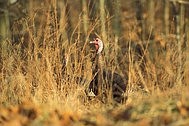For turkey hunters, the season looks to be promising for the state at a time when losses of habitat and increasing populations of predators have contributed to decline numbers of turkeys.
One of those regions where turkey production appears to be on an upswing is in Morgan, Miller and Maries counties, while the hunting in other Central Missouri counties may be a bit more challenging.
According to the Missouri Department of Conservation's (MDC) annual wild turkey survey for 2021, average turkey production statewide was similar to production at the statewide scale in 2020, but better than statewide production from 2016-19.
MDC's statewide poult-to-hen ratio (PHR) - an index for turkey production - this year was 1 percent, which was the same as last year. But it is 11 percent greater than the average production observed during the previous five years.
When comparing the statewide PHR to the average turkey production observed during the last 10 and 20 years, production in 2021 was below the long-term average.
For hunters in Ozark Border Region, which includes Morgan County, turkey production was up 43 percent. In the Ozarks West Region, which includes Miller and Maries counties, turkey production increased 57 percent.
For Callaway and Boone county hunters, or the Lindley Breaks Region, turkey production had a 9 percent increase.
But for Cole, Moniteau and Osage counties, or the Union Breaks Region, turkey production was down 8 percent. In 2020, the region had been experiencing production increases.
Since 1959, MDC has conducted an annual wild turkey brood survey where MDC staff and citizen volunteers record the number of hens and recently hatched turkeys, which are called poults, they see during June, July and August. These observations are then tallied to determine the success of the hatch, which is most often reported as a poult-to-hen ratio, or simply the average number of poults per hen observed during the survey.
The poult-to-hen ratio is a good measure of nesting success and poult survival, said Reina Tyl, MDC wild turkey biologist.
"Each year, thousands of citizens participate in the survey, and we are grateful for their contribution," Tyl said. "This year during the three-month survey, participants reported sightings of more than 75,000 turkeys, which is a testament to the large number of dedicated volunteers that take time to record and submit their observations."
Tyl added a lot has changed during the last several decades that could be contributing to the declining trend in productivity.
"There have been broad-scale losses of quality nesting and brood-rearing habitat, changing spring weather patterns, increasing populations of some nest and poult predators, and declining insect abundance - a critical food source for young poults," she said.
MDC partnered with the University of Missouri to launch a cooperative research project last year to determine how these different factors are affecting wild turkey nest success and poult survival.
"The project also aims to identify the main causes of poult mortality and determine how brood-rearing habitat selection, and the quality of those habitats, affects poult survival," Tyl said. "The information gathered from this study will inform management of wild turkeys and turkey habitat in Missouri."
To participate in the annual wild turkey brood survey, email MDC's Wild Turkey Management Program at [email protected] with "Wild Turkey Brood Survey" as the subject of the email. Include complete name and mailing address.
For a more detailed report outlining the results of the 2021 Missouri Wild Turkey Brood Survey and to read reports from previous years, visit the Turkey Reports webpage at mdc.mo.gov/hunting-trapping/species/turkey/turkey-reports.

